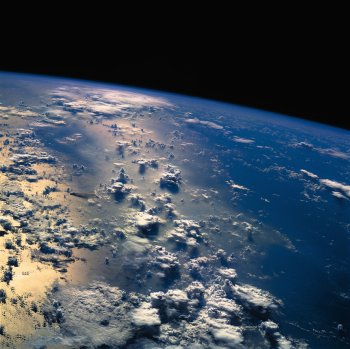I woke up way too early this morning and couldn’t get back to sleep. My wandering mind began to think about the recently-discovered “Goldilocks planet”, Gliese 581 g. Goldilocks is about three times the mass of Earth, so if it’s got a similar composition, it’s going to be around 1.4 times Earth size. (Volume depends on the cube of the radius.) Surface gravity would be about 1.5 times what we feel on Earth. You’d feel heavy, but it would be tolerable enough.
 It’s not known yet if Goldilocks has an atmosphere, but we might guess that it has, and given the higher gravity, a denser one than ours. That’s important because Goldilocks is so close to its sun that its rotation must have been stopped by tidal forces, and it will have one hot side and one cold side. A thick blanket of atmosphere will both distribute and equalise the sun’s heat, and also have a greenhouse effect, raising the average temperature. Some guesswork and calculations by astronomers suggests that the average temperatures on Goldilocks will be something like Earth’s polar regions, but with some places being warm enough for liquid water, if there is water.
It’s not known yet if Goldilocks has an atmosphere, but we might guess that it has, and given the higher gravity, a denser one than ours. That’s important because Goldilocks is so close to its sun that its rotation must have been stopped by tidal forces, and it will have one hot side and one cold side. A thick blanket of atmosphere will both distribute and equalise the sun’s heat, and also have a greenhouse effect, raising the average temperature. Some guesswork and calculations by astronomers suggests that the average temperatures on Goldilocks will be something like Earth’s polar regions, but with some places being warm enough for liquid water, if there is water.
The distribution of heat that I mentioned is done by weather. The pattern of weather on Earth is caused by the poles getting less heat from the Sun than the equator, and the winds which this creates are all twisted up by the Earth’s rotation. On Goldilocks, there will be a much bigger temperature difference, but no rotation. I’d imagine that the result would be permanent strong surface winds blowing from the cold side to the hot side, and high-level winds blowing the opposite way, but I can’t really get an image in my head of exactly how that would work, and what weather it would create if there were clouds and rain. I’m sure sombody somewhere is working on a computer simulation of it.
It occurred to me that Goldilocks would be a much more convenient planet if it was rotating, and I began to wonder how you might get it turning. There’s a fair amount of solar energy going spare on the hot side, but it would be tough to turn it into a planet-moving force. Making an entirely arbitrary and unscientific guess, I thought you might be able to build some sort of solar-heated steam rocket that could convert a square metre’s worth of solar power into a newton of thrust. (One newton is the downward force exerted by about 100g in Earth’s gravity field. A large apple, say. Newton, gravity, apple.)
 So you’ve got a robot rocket factory on the surface of Goldilocks and it’s churning out these steam rocket things. Ten thousand per year maybe? How fast would ten thousand newtons turn a planet? Since this was me lying in bed trying to work it out in my head, I decided that angular momentum of a solid sphere was too difficult, and tried to think of an analogy where you were pushing on a planet-sized dumbbell. With some very dodgy order-of-magnitude calculations, I worked out that you could match Earth’s rotation in, oh, a million times the age of the universe. (Actually, I’ve just checked that and it seems correct.)
So you’ve got a robot rocket factory on the surface of Goldilocks and it’s churning out these steam rocket things. Ten thousand per year maybe? How fast would ten thousand newtons turn a planet? Since this was me lying in bed trying to work it out in my head, I decided that angular momentum of a solid sphere was too difficult, and tried to think of an analogy where you were pushing on a planet-sized dumbbell. With some very dodgy order-of-magnitude calculations, I worked out that you could match Earth’s rotation in, oh, a million times the age of the universe. (Actually, I’ve just checked that and it seems correct.)
That’s just with the original ten thousand machines. If the robot kept making them… well, that was a bit too much for my brain. Then I realised that Goldilocks, being tidally locked, probably isn’t a perfect sphere. Even Earth gets pulled out of shape by the Moon’s gravity, so Goldilocks must be somewhat egg-shaped, although I have no idea by how much. Some tens of kilometres at least, meaning that any attempt to rotate the planet would have to lift cubic kilometres of rock through the host sun’s gravity field. In essence, there would be a force pushing back on any attempt to rotate the planet and unless you were pushing harder, it wouldn’t turn at all, even in a billion years.
It was at that point that I decided to abandon Goldilocks and go find a nicer planet. A little blue one, with spirals of white cloud and nice oceans.